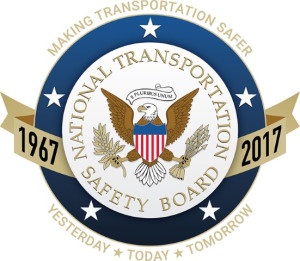Two Key Transportation Agencies Turn 50
Both the U.S. Department of Transportation and the National Transportation Safety Board have just celebrated their 50th anniversaries.
Two key U.S. agencies involved in constructing and regulating transportation infrastructure and the transportation industries, as well as investigating significant transportation accidents, marked milestones in the past week: Both the U.S. Department of Transportation and the National Transportation Safety Board have just celebrated their 50th anniversaries.
DOT held an open house to commemorate it, with new DOT Secretary Elaine Chao welcoming former secretaries Elizabeth Dole, Mary Peters, and Norm Mineta; Chao's husband, U.S. Senate Majority Leader Mitch McConnell; Sen. John Thune, chairman of the Senate Commerce Committee; Bill Shuster, chairman of the House Transportation & Infrastructure Committee; Virginia Gov. Terry McAuliffe; and others.

NTSB came into existence on April 1, 1967, after President Lyndon Johnson recommended that it be created. Acting NTSB Chairman Robert L. Sumwalt wrote a post for the agency's blog that traced some of its history. From March 2, 1966, to NTSB's creation a year later, "there was a spate of disastrous commercial aviation crashes, either on US soil or involving US-built aircraft, together taking the lives of hundreds of passengers. This was not extremely unusual for this era; sometimes multiple fatal aviation accidents happened during the same month," he wrote. "At the same time, the roads were full of automobiles that could never be sold under today's safety standards. Most cars had no seat belts, and those that did generally had them in the front seat only. Air bags and child safety seats had not made their way into production. Drunk driving laws and enforcement were permissive, and even with far fewer cars on the roads, there were far more crash deaths.
"Before the NTSB, major accidents in aviation were investigated by a section of the Civil Aeronautics Board, or CAB. Accidents in other modes of transportation might be investigated by a special subcommittee or jury, but there was no agency to coordinate these efforts or to collect the various findings and analyze them. The written testimony of government officials in favor of creating the NTSB put it this way: 'There is no single official in the entire Government who is in a position to identify, study, and propose solutions to transportation problems.'
He added that NTSB was established to ask "why?" when an accident happened and to ask "why not?" about improving regulations, training, or a certain aspect of the vehicle or the environment. "Even in its infancy, NTSB reports included, as they do today, recommendations to prevent future accidents, often pointing industry and regulators toward a safer future. Although action on NTSB recommendations is purely voluntary, more than 80% of our recommendations are acted upon favorably," he explained.